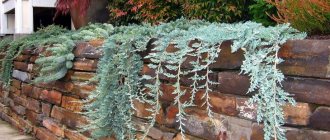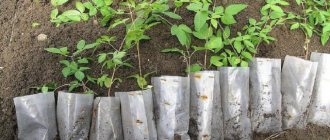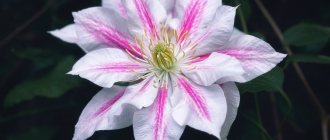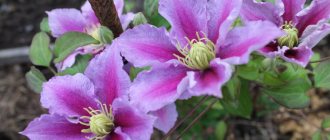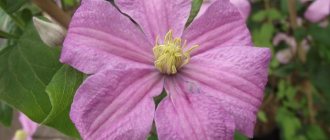09.02.2019
Categories: pink, large-flowered, pruning group 3, winter-hardy, for the Moscow region
The clematis variety "Ville de Lyon" was obtained in 1899 by the French florist Francisco Morel. This is a very unpretentious, winter-hardy, profusely flowering and decorative variety, valued by flower growers all over the world.
Description
Caper Ville De Lyon is one of the most popular Clematis varieties cultivated around the world. One bush produces up to 15 shoots with pale brown bark, becoming brown as it matures.
The length of the shoots can reach 3-4 m. At the same time, they are characterized by fairly active growth - per day the young growth is 10 cm.
On each branch of the vine, about 15 large flowers with a diameter of 12-15 cm, sometimes 20 cm are formed. The buds consist of 5-7 simple petals. In the center they are painted carmine red, along the contour the shade gives way to purple. The stamens are pale yellow.
When exposed to excessive light, the inflorescences fade to light pink or almost white.
The leaves are small, heart-shaped. Due to the fact that the vine does not cling to the support with its branches, it acts as a device for conquering the adjacent territory.
The root system is powerful; an adult plant can weigh up to 5 kg. It is represented by a shortened main root with many thin secondary ones.
The flowering period occurs in the 3rd year from the moment the seedling is planted in a permanent place and lasts from July to September.
Among the advantages of culture are:
- resistance to fungal diseases;
- minimum care requirements;
- high levels of frost resistance;
- the opportunity to create a beautiful hedge every year;
- abundant, long-lasting flowering.
Reviews about this variety
Clematis Ville de Lyon is the most popular French hybrid among domestic flower growers.
The history of this hybrid goes back 120 years and during all this time its popularity has never decreased. Rich clematis bushes Ville de Lyon are found in almost every garden. You can recognize this creation of breeders by the following varietal characteristics:
- Clematis Ville de Lyon is a climbing plant of the shrub type of the Ranunculaceae family.
- Its curving brown stems can grow up to 3-4 m in length. The color of adult shoots is brown, and the color of young branches is light brown.
- The inflorescences of the vine are large; when open, they are 14-16 cm in diameter. The color of clematis is original: its petals have a fuchsia color, but as they wither they acquire a pronounced purple tone. The flower is formed from 6 sepals and bright yellow, densely pubescent stamens.
- The flowering of Clematis grandiflora Ville de Lyon is long and abundant. The first flowers bloom at the end of July, or in the first days of August if the spring was cool. And before the arrival of the first frost, clematis continues to delight the eye with its flowering for a long time.
Clematis Ville de Lyon is popular not only for its exquisite beauty. The variety has many advantages that are not inherent in other types of vines.
- Clematis Ville de Lyon exhibits enviable resistance to fungal diseases.
- The variety has high winter hardiness, so it does not require annual digging in harsh regions. In addition, it is a perennial.
- The undeniable advantage of this clematis is its unsurpassed flowering, fast growing season, ease of care and propagation.
Clematis Ville de Lyon is especially popular in Western Europe, where it is often used to decorate gardens, gazebos and other vertical surfaces. This is explained by the fact that this hybrid variety was bred in France, and from there it spread to other regions (Figure 2).
According to the botanical classification, clematis Ville de Lyon is a climbing shrub-liana with shoots about 3 meters long. The inflorescences are large, painted bright pink, which turns purple as the bud fades. This variety is characterized by long flowering, which begins in late July-early August (depending on the region) and continues until late autumn.
Figure 2. External features of the variety
The obvious advantage of the variety is its unpretentiousness. Since even young plants are resistant to fungal diseases and frost, the owner will need a minimum of effort to grow a beautiful and profusely flowering vine. The liana can even winter in the garden without special shelter, and the rapid growth of shoots will help decorate your site with a beautiful flowering plant in the shortest possible time.
Based on the description provided by the originators, clematis variety Ville de Lyon belongs to the Viticella group. Simply put, these are clematis that form buds of predominantly purple shades exclusively on new vines formed in the current season.
The clematis variety Ville de Lyon forms a bush of vines up to 3-3.5 meters long. Young shoots have a reddish tint and become brownish-brown over time. The stems are covered with medium-sized heart-shaped leaves. The plant is densely leafy, and before flowering in July it looks like a green carpet of rich emerald shades. It grows quickly, forming up to 5-6 new shoots per season.
The clematis variety Ville de Lyon is an absolutely unpretentious plant, judging by the reviews of experienced gardeners.
- It grows well on any type of soil, except, probably, very heavy and clayey or acidified ones.
- It is cold and frost resistant. In the climatic conditions of the middle zone it can winter without shelter.
- The Ville de Lyon variety is undemanding in care and has high immunity to most diseases of fungal and viral nature;
- Clematis Ville de Lyon not only produces more shoots every year, but also increases the number of flowers.
Interesting fact!
Breeders classify clematis Ville de Lyon as a hybrid variety that not only can, but to some extent should be planted in shaded areas of the garden. Otherwise, its large flowers lose their brightness. Which, however, does not affect the external attractiveness of the plant.
The Ville de Lyon variety is one of the best choices for both novice gardeners taking their first steps in growing clematis, and for professionals who want to bring new shades to their garden.
Despite the fact that the Ville de Lyon variety is not currently zoned and not included in the State Register of the Russian Federation, its unpretentiousness and frost resistance make it possible to grow flowering vines in the Southern, Central and Northwestern regions.
The unpretentious clematis Ville de Lyon belongs to the third pruning group. This means that its pruning, although strong, does not require any effort or special knowledge.
Pruning of faded shoots of clematis Ville de Lyon is carried out in the fall, some time before covering the plants for the winter. Cut the stems to a height of 15-20 cm from the surface of the ground, leaving two or three buds on each. Once every five to six years, it is recommended to carry out a complete deep pruning of clematis variety Wilde Lyon, cutting off all shoots at the root.
During the season, clematis variety Wilde Lion is periodically inspected and dried or diseased shoots are removed.
Unlike many varieties that form flowers on new and old shoots, large-flowered clematis Ville de Lyon forms inflorescences exclusively on the stems of the current season. The period when its intensive flowering begins occurs in mid-July. That is why he is valuable.
As a rule, at this time there is no riot of colors in the garden plots. The first spring and summer flowers have already faded. The autumn ones are just gaining strength. Therefore, a luxurious vine, completely covered with bright flowers, will come in handy. The formation of flower stalks continues until mid-September.
The inflorescence shape of clematis Ville de Lyon (see photo) is one of the simplest. Nevertheless, she amazes with her gentle charm. The bud, reaching a diameter of 10-12 cm, consists of five to six ellipsoidal, corrugated petals with a slightly wavy edge. Their sharp outer ends are slightly concave inward.
The color of the petals varies from purple to dark purple with purple veins. In mid-summer, the petals of plants growing in sunny places may change color. In this case, at the edges they remain a rich purple color, and in the center they acquire a light lilac hue with white veins.
It is noteworthy that the buds in the lower or middle part of the clematis bush are subject to burnout. As a result, by August it forms a waterfall of large flowers of various shades with light, creamy centers, the stamens of which reach two centimeters.
Attention!
Unfortunately, after several years, the flowers of clematis variety Ville de Lyon become smaller. To prevent this from happening, you should fertilize and trim the shoots in a timely manner.
Since the Ville de Lyon variety grows well in partial shade, it is ideal for decorating the trunks of old trees or for planting next to shrubs and trees that have early flowering periods. For example, with lilac or honeysuckle.
Peonies will look great at the foot of the Ville de Lyon clematis. At the beginning of summer they will add bright colors to the bush, in the middle they will provide shade to its root system and save the lower tiers of flowers from burning out.
Clematis Ville de Lyon was developed in France in 1899. This is a hybrid variety from the Viticella group of clematis.
For its spectacular flowering and relative unpretentiousness, this variety is still very popular in Europe and Russia. It grows well and blooms profusely every year in gardens in the Moscow region and Leningrad region.
Clematis Ville de Lyon is a vine clinging to leaf petioles up to 3 meters high. The leaves are pinnately compound or trifoliate. At the very bottom of the shoots, the leaves dry out at the end of summer - this is a normal phenomenon, a natural feature of this variety. The bushes form many shoots and grow quickly.
Clematis Ville de Lyon - an unpretentious variety with large bright crimson flowers
Flowering is very abundant, occurs on the shoots of the current year and lasts from June to September. Buds and flowers are directed upwards. The diameter of the flowers reaches 13 centimeters, the length of the pedicels is up to 15 centimeters. The flowers are fully open, of 6 petals, intense crimson, fading to pale pink in the bright sun. The petals are wide, partially overlapping each other. The anthers are yellow.
Clematis Ville de Lyon is characterized by abundant flowering
This variety belongs to the third pruning group: all shoots are pruned short for the winter, which is very convenient for growing in central and northern regions with frosty winters. Without shelter, it can withstand winter temperatures down to -25 degrees.
Ville de Lyon does not like extreme heat. In southern regions with hot summers, it is better to plant this variety in a slightly shaded place to prolong flowering.
READ MORE: What is tarragon, growing tarragon properties
I saw a luxuriously blooming clematis bush Ville de Lyon in Kazan in the garden of my grandmother’s friend. The spectacle is stunning: the wall of the veranda is almost completely covered with large crimson flowers. We also planted this variety, the plant took root and grew to flower, but died in one of the extreme winters, when 35-degree frosts lasted more than a month.
Ville de Lyon is a beautiful and unpretentious clematis that can decorate any garden. This variety is well suited for beginners, and its spectacular abundant flowering delights even experienced gardeners.
Ville de Lyon is a popular clematis variety that is a beautiful vine with fuchsia flowers. Openwork foliage and large, luxurious inflorescences are why domestic summer residents love this variety so much. This variety is often used to decorate balconies, gazebos, and create hedges.
Landing Features
You can get a healthy and abundantly flowering shrub only if it is correctly located on your personal plot.
If all standards are followed, the risk of damage to seedlings that are especially sensitive to diseases is minimized.
The timing of planting large-flowered clematis directly depends on the condition of the root system. If it is closed and the plant is in a container, then there are no restrictions on this criterion, with the exception of winter.
A shrub with open roots can be planted in a flowerbed both in autumn and spring, in warm weather with a stable temperature. The optimal months for the event are September, October.
Selection and preparation of a site
When choosing a location for Ville De Lyon, a number of nuances should be taken into account.
Clematis ville de lyon pruning group
- The culture is photophilous, so the site for it should be well lit. However, under prolonged exposure to direct sunlight, the flowers fade, which significantly reduces the decorative value of the shrub.
- The roots of the vine need shading. In meeting this requirement, it is necessary to understand that constant stagnation of moisture has a detrimental effect on the underground part of the plant and leads to rot. Ideally, the site should be at a relative elevation with deep groundwater. If there is no such area in the garden, artificially raise the soil level and create a good drainage layer.
- Flowers are also afraid of strong drafts. Therefore, open areas are not suitable for growing. A prerequisite for the comfortable growth of Clematis is the presence of a shelter in the immediate vicinity - a fence or any other building.
- The soil should be fertile, preferably loamy with a slightly alkaline or neutral environment.
Preparation of planting material
For planting, it is recommended to take seedlings with a strong root system that have reached 2 years of age.
Before the procedure, open roots are inspected and, if necessary, dry segments are trimmed. Afterwards, the damaged parts are placed for a couple of hours in a solution of potassium permanganate and planted in the ground.
Landing technology
To begin with, dig a hole measuring 0.6 * 0.6 * 0.6 m. When placing a group of plants, maintain a distance of at least 1 m.
Then:
- Lay out drainage from crushed bricks, crushed stone, gravel. Recommended thickness is 15-20 cm.
- Fill the hole ½ full with fertile soil, to which 400 g of wood ash, 1 bucket of humus and 50 g of superphosphate are first added. If necessary, reduce acidity by adding 150 g of lime.
- Install the support, then the seedling. It is positioned so that the lower bud is 8 cm below the ground level, but is not covered with soil. As a result, a bowl-shaped depression should remain, which should be gradually filled in over the course of the season.
- The surface is compacted and watered abundantly. Sprinkle a layer of mulch on top.
Planting and caring for Clematis Ville de Lyon
If you plant correctly, problems such as poor flowering, root rot, and fungal diseases will not arise in the future. And also there will not be a lot of debris on the site due to the falling of flowers and leaves.
Recommended timing
The timing of planting the Ville de Lyon variety depends on the form in which the roots of the Clematis Ville de Lyon vine are located. Planting bushes with an open root system is carried out in spring or autumn. The best time is considered to be the months of September and October.
If the seedlings are in containers, then they are planted at any time except winter.
Choosing a suitable location
The place for planting the Clematis Ville de Lyon variety is chosen taking into account the needs of the loach:
- the plant is sun-loving, so the side should be sunny;
- the roots need shade, but they can rot from constantly wet soil;
- flowers are afraid of strong air movement.
Important!
The most favorable soil for planting will be loamy soil with a slightly alkaline or neutral environment, fertile, well fertilized with deep groundwater.
Selection and preparation of planting material
The best planting material is considered to be seedlings with a well-established root system that have wintered under snow for 2 years.
Preparation of planting material, despite the different methods of propagation of the Ville de Lyon variety (division, layering, cuttings), is approximately the same. If the roots are open, then cut off the broken and dry ones. The damaged ones are dipped in a strong solution of potassium permanganate for a couple of hours.
Support
To avoid damaging the roots of clematis Ville de Lyon, the support is installed before planting. The device can be purchased ready-made or constructed independently.
Requirements for the support:
- height from two, width from one and a half meters;
- strength, reliability;
- sustainability;
- fit into the overall design;
- decorativeness.
If trellises for clematis are installed along the facade of the house, then in winter, when the plant is dormant, they should not spoil the appearance of the building. In addition to trellises, arcs are constructed from PVC pipes. Forged metal supports are durable.
One of the less labor-intensive options is to dig in two wooden posts, stretch and secure a galvanized chain-link mesh between them. They do it even simpler - they drive nails into the wall of the gazebo and stretch a strong twine along which the vines will weave.
Landing algorithm
Since the Clematis Ville de Lyon variety can grow in one place for many years, it is necessary to carefully prepare the site and plant:
- For one bush, dig a hole measuring 0.6 x 0.6 x 0.6 m. If there are several bushes, place them at a distance of about a meter from each other.
- Place drainage in the form of crushed stone, coarse sand or broken brick at the bottom of the hole to a height of 15-20 cm.
- Fill halfway with fertile soil and water.
- Place the bush in the middle of the hole so that the lower pair of buds is 8 cm below the ground level.
- Fill the hole with soil, tamp it down and pour plenty of water again.
Advice!
When planting, it is recommended to immediately install a support along which the vine will climb, so as not to damage the roots of the plant in the future.
Care
Watering
In a temperate climate, Clematis is watered rarely, but abundantly. The bush is irrigated with 3 buckets of water per week. In hot weather, the procedure is performed more often. In this case, care should be taken to ensure that the soil does not become waterlogged and that the top layer has time to dry out.
Ville de Lyon clematis reviews
Feeding
A guarantee of abundant flowering of the crop is timely feeding. They are made several times during the season:
- In the spring. The plant is watered with lime milk at the rate of 200 g of lime per 10 liters of water.
- In summer. At the stage of active vegetation, they are fertilized with nitrogen preparations, during the budding period - with mineral complexes.
- In autumn. Wood ash and plant humus are added under the root.
Mulching and loosening
Loosening the soil allows you to saturate it with oxygen and prevents the active growth of weeds. Do the procedure regularly if there is no mulch in the space around the trunk.
In addition to its protective properties, the layer maintains the humidity of the substrate at the required level and prevents it from freezing in winter. Sawdust, spruce needles, and crushed bark are used as covering materials.
Trimming
The Ville De Lyon variety belongs to pruning group 3. The procedure is carried out in the fall - the shoots of the plant are almost completely cut off, while leaving the 3 lower growth nodes intact. The maximum permissible length after cutting is 20 cm.
In the spring, when the branches begin to actively sprout, a sanitary correction is made, during which all dry and damaged segments are removed.
Aftercare for Clematis
The Clematis Ville de Lyon variety does not require much attention. And at the same time, he is able to elegantly decorate the garden area for many years, as can be seen from the photo below. It is only necessary to carry out small measures to care for it after planting.
Watering
Under normal climatic conditions, it is recommended to water Clematis infrequently, but abundantly. In hot weather, you need to increase watering, but make sure that the roots of this variety are not constantly in soggy soil. Gardeners recommend watering the roots, leaving the leaves and flowers dry.
Top dressing
For full flowering, the Clematis Ville de Lyon variety needs regular fertilizing. In spring, this is watering with lime mortar (200 g of lime per bucket of water). During the season - fertilize the plant with nitrogen and mineral complexes at least 3 times. In the fall before wintering - humus and wood ash.
Mulching and loosening the soil
Regular tillage of the soil by loosening saturates it with oxygen and prevents weeds from growing rapidly. Mulching helps maintain optimal humidity and temperature conditions at any time. When mulch rots, it enriches the soil with useful elements. If there is not enough mulch, it needs to be supplemented.
Pruning Clematis Ville de Lyon
During the entire growing season of the shrub, sanitary pruning can be carried out, removing dried and broken stems, thereby regulating the growth of the loach.
Clematis Ville de Lyon pruning group is 3 and is carried out in the fall. This is the deepest pruning with complete shortening of the stems. Before sheltering for the winter, trim the branches with garden shears, leaving a section with 2-3 nodes above the ground (the width of your palm).
Preparing for winter
Before the onset of frost, the bushes are hilled up, the stems are deeply pruned, leaving small stumps at the roots. In regions with a temperate climate, this is done in mid-October.
Preparing for winter
In addition to pruning, on the eve of cold weather, the bushes are hilled up, sprinkled with humus and fallen leaves. In regions with harsh climates, more serious shelter is made.
Clematis ville de lyon reviews
If the area in winter is characterized by sub-zero temperatures (below 25°C), the plant is covered according to the following scheme:
- An inverted wooden box is placed on the shortened shoots.
- Spruce branches are laid on top.
- Insulate with burlap.
- If there is a small amount of precipitation in winter, sprinkle the shelter with snow with your own hands.
Clematis propagation methods
The main method of propagation of the Clematis Ville de Lyon variety is vegetative. It is carried out:
- roots;
- layering;
- cuttings.
Propagation by roots of Clematis Ville de Lyon is the most popular method, according to reviews from gardeners, it gives quick results. To do this, a young bush is dug up in spring or autumn, cleared of soil and divided into several parts.
Important! The old bush does not need to be completely dug up. All you have to do is dig down from the side and cut off a part with a shovel.
For propagation by layering, depressions of up to 10 cm are made around the bush, shoots that have grown in spring are placed there, secured in the ground, and sprinkled with fertile soil. Regular care: watering, fertilizing, loosening. In winter, the stems that have given roots are left in the ground, generously sprinkled with mulch. After a year, the rooted shoots are dug up and planted in a new place.
Propagation of the Clematis Ville de Lyon variety by cuttings is an industrial method popular among gardeners. For it, green or woody parts of the shoots are used. It is good because it does not transmit diseases to the mother plant.
Reproduction
Seeds
A rather labor-intensive and time-consuming method, extremely rarely used by amateur gardeners. Clematis seeds have poor and uneven germination; germination can take up to 8 months. The event should be held immediately after collecting the material.
Growing technology:
- Soak the seeds for about 30 minutes in a solution of Epin or succinic acid. To improve germination, they are pre-stratified.
- Drainage is distributed at the bottom of a low container, and a mixture of garden soil, peat, and river sand is poured on top.
- Furrows are formed, seeds are laid in them to a depth of no more than 1.5 cm. Sprinkled with substrate. Moisten with a spray bottle.
- Place the container in a warm room with diffused light. After 3-4 weeks, the first shoots appear.
- When 2-3 true leaves appear, the seedlings are planted in separate containers.
Cuttings
It is preferable to propagate the variety by cuttings in summer. The shoots are taken from a bush that has been growing in one place for at least 3 years, and no more than ⅓ of the entire length of the lash is cut off.
Clematis Ville de Lyon photo
The readiness of the shoot for reproduction can be judged by its condition - it should not break during transformation. It is also better if there are no flowers on the branch.
The cut is treated with a growth stimulator, after which it is stuck into the substrate at an angle. The latter is made two-level: the lower layer consists of river sand and humus in equal proportions, the upper layer is represented by perlite.
Subsequently, they are placed in a greenhouse or covered with film, maintaining high humidity and a temperature of about 22-25 degrees in the containers. After 5-6 weeks, the first leaves appear on the cuttings, which indicates that the rooting procedure was carried out correctly.
By layering
To obtain layering, a hole 10 cm deep is dug near the bush, into which the shoot is bent and covered with earth. Further care is carried out according to the standard scheme.
When young shoots appear, the plant is separated from the mother plant and moved to a new location.
Dividing the mother bush
Propagation of Clematis by division of rhizomes is one of the most popular and productive methods of propagation. During the procedure, an adult plant is dug up on one side, part of the rhizome is cut off with a shovel and replanted.
Features of cultivation
Clematis Ville de Lyon can be purchased as a strong seedling and planted on your site. But it is much more interesting to grow this beautiful vine from seeds. Success primarily depends on the quality of the purchased seed material, so it is better to make a purchase in trusted stores or nurseries.
The process of sowing clematis Ville de Lyon seeds is not much different from growing other varieties of clematis.
- The seeds of this variety are large, so they take a long time to germinate. To improve germination, they are stratified. To do this, the seeds are placed in the freezer for half an hour, then taken out and kept for 2 hours at room temperature. This algorithm of actions is repeated three times.
- After stratification, the seeds are treated with a growth stimulator, washed, laid out on a flat surface, covered with glass and left in a dark place at a temperature of 25⁰C.
- After 4 days, the shelter is removed from time to time to allow the seedlings to ventilate.
- After 10-12 days, sprouts hatch from the seeds.
- At this stage, the seeds can be sown in the soil. A mixture of fertile substrate and sand is used for clematis. The seeds are covered with a thin ball of earth, which is slightly rolled.
You can also sow seeds in open ground. Before sowing, they are stratified for about 3 months at temperatures up to 4⁰C. Sowing is carried out in spring or autumn. In the latter case, the seeds are covered with a ball of snow, which should last all winter, or immediately after sowing, the bed is mulched with sawdust and covered with additional shields.
Flowering of clematis Ville de Lyon grown from seeds occurs in 2-3 years. When exactly this happens depends on climatic conditions and care of the vine.
Ville de Lyon is an ideal variety for planting near walls, fences, and for decorating gazebos. The liana climbs trees and bushes beautifully.
Knowing how to grow clematis from seeds and what special care features exist, you can easily transform your summer cottage plot with the help of a beautiful vine within a season.
Therefore, it makes sense to consider the rules of planting and the nuances of cultivation. Plants are planted in spring or autumn. The most optimal planting dates are September and October.
How to plant clematis seeds is described below:
- Purchase planting material. Soak the seeds for a while. Sow the sprouted seeds in small pots with fertile soil. When sprouts appear, transfer them to a permanent place of growth.
- Decide on a place to plant the vine. It is better to choose an area with partial shade. You also need to make sure there is support for the plant, along which it will climb up as it grows. It should be noted that the support for clematis with your own hands should be high - at least 2 meters. Its optimal width is 1.5 meters. Chain-link mesh is the best option for support. A fence would also work.
- The distance between seedlings should be maintained at 80 centimeters.
- When planting, superphosphate, wood ash and humus are added to the hole. If the acidity of the soil is high, add lime. To ensure that the soil allows moisture to pass through well, a drainage layer consisting of crushed brick or large pebbles is placed at the bottom of the hole.
- Before planting, the roots of a young plant need to be dipped in a clay mash.
- Deepen the seedling into the hole.
- Cover the hole with soil.
- Cover the crop circle with mulch.
The clematis variety Ville de Lyon is characterized by fast growth, so it is great for decorating walls, gazebos and other vertical structures. The easiest way to grow such a crop on your own plot is by planting seeds and then planting the grown seedlings in open ground (Figure 3).
The algorithm for growing a hybrid clematis variety looks like this:
- The purchased planting material needs to be soaked in warm water for a while. To speed up the process, you can add a little growth stimulator to it.
- As soon as small sprouts and roots appear on the seeds, the seedlings can be transplanted into separate small pots filled with fertile soil.
- Next, you need to wait until the sprouts hatch on the surface of the soil, and you can transfer the future seedlings to a more suitable place for further growing. As a rule, germination is carried out in a warm and moderately lit room, and further cultivation of future seedlings is carried out in a room with good lighting.
When the plants get stronger, they can be transplanted to a permanent place in the open ground. To do this, it is better to decide in advance on the site for placing the vine and prepare it.
To create a beautiful and moderately dense clematis hedge, it is recommended to plant plants at a distance of 80 cm from each other. Also, during planting, it is necessary to add nutrients to the soil that will provide the plants with all the necessary vitamins and microelements for full growth.
To do this, wood ash, superphosphate and humus are added to the pit directly during planting. In areas with high soil acidity, additional lime can be added. In addition, it is advisable to arrange drainage in each planting hole: lay out a layer of crushed brick or large pebbles.
Figure 3. Liana propagation by layering and growing from seeds
When the planting site is ready, you can begin to directly move the seedling to a permanent location. It is advisable to dip the roots of each plant in a clay mash, then place the seedling in the center of the hole, slightly deepen it and sprinkle the hole with earth. To preserve moisture and nutrients in the soil, it is advisable to cover the tree trunk circle with a layer of organic mulch (Figure 4).
Despite the unpretentiousness of clematis of the Ville de Lyon variety, they still need certain care:
- Keep in mind that for the first 2-3 years the plant will simply increase its vegetative mass and develop its root system, so it makes no sense to wait for active flowering during this period.
- The first buds will appear only in the third or even fourth year after planting in a permanent place. If buds appear on the shoots before this moment, it is better to remove them in order to save the crop’s energy and the plant can develop shoots better.
- Fertilizers for clematis of this variety are applied three times per season, and for this purpose it is better to use special fertilizers for flowering plants.
- The vine does not need a special watering schedule: moisture is added only as the top layer of soil dries, and if there is sufficient natural precipitation, additional watering will not be needed at all.
- To form a beautiful and profusely flowering plant, clematis needs to be pruned periodically. The procedure is carried out in spring or autumn, and the pruning should be quite strong: all shoots are shortened by an average of 7 mm above the last bud. In this case, the distance from the ground to the flower bud should be at least 20 cm. Only with this formation of the bush can you get a lush and beautiful vine.
Hybrid clematis Ville de Lyon does not need special shelter for the winter, but in regions with frosty winters or where snow cover is minimal, it is still better to prepare the vine for winter. To do this, the plant needs to be hilled up and covered with a layer of peat or sawdust. This material will both protect the plant from the cold and act as mulch, retaining moisture and nutrients in the soil.
Figure 4. Main stages of care: pruning and tying to supports
In the future, when the clematis bush has grown sufficiently, it can be propagated by one of the available methods: cuttings, layering or dividing the bush. When using the cutting method, at the beginning of summer, cuttings are taken from adult shoots, using for this purpose the middle part of the shoot with two buds and one internode.
READ MORE: New Georgian lemon care at home
The second method, which uses layering, is considered more reliable. In this case, shallow grooves (no more than 5-7 cm) are dug around an existing vine and young shoots are placed in them. The branches need to be fixed to the surface of the soil, sprinkled with soil and watered abundantly. During the summer, each such shoot will grow into a separate vine with its own rhizome, which in the summer can be separated from the mother plant and transplanted to a new place. In this case, it is highly advisable to cover the bed with layering for the winter.
Propagation of clematis Ville de Lyon by dividing the bush is also considered very effective. But to do this, you will have to carefully dig up an adult plant and divide it into several parts so that each of them contains at least 2 developed shoots. If the plant is old and firmly rooted in the ground, there is no need to dig it up completely: it will be enough to simply separate the desired part of the rhizome and replant it in a separate area.
Ville de Lyon, like all varietal clematis, requires:
- good sunlight;
- protecting the root system from overheating;
- permeable, fertile, non-acidic soil with a pH of at least 7.
The landing location depends on the region:
- In the central and northern regions, it is better to plant near the south-eastern or south-western walls, retreating at least 70 centimeters from the foundation to the nearest edge of the planting hole.
- In the southern regions it is necessary to plant so that during the hottest afternoon hours the flowers are in partial shade.
The root system of clematis is afraid of overheating and needs mulching or shade even in the middle zone. You can plant low-growing flowers with a shallow root system under clematis; this shades the soil and looks beautiful. Wood chips or gravel are suitable mulches.
Planting holes are dug with a depth and diameter of 60 centimeters. On clay soil, a drainage layer of 10–15 centimeters of broken brick is required at the bottom of the pit. The root collar of the seedling after planting should be located 8–12 centimeters below the soil surface. Best landing time:
- in the southern regions - April or September;
- in the central and northern regions - May.
When planting clematis, the root collar is buried 8–12 cm below the soil surface.
Diseases and pests
| Name | Symptoms | Prevention | Treatment |
| Fusarium | A brown border along the contour of the leaves, eventually expanding towards the center. Affected leaves and apical shoots dry out. | Regularly feed with phosphorus-potassium preparations, refrain from introducing aggressive organic matter. Water the roots with a solution of potassium permanganate with the addition of boric acid once a season. Do regular weed removal and loosen the soil. | Carry out radical pruning to the base. They are treated with special preparations: Agat-25K, Baktofit, Trichodermin, Vitaros, Potassium Humate. |
| Powdery mildew | White powdery coating on all parts of the plant; as the disease progresses, brown spots appear, leaves dry out and fall off. | Avoid overcrowding of plantings and the application of large amounts of nitrogen fertilizers, and promptly remove plant waste. Spray with mustard solution (2 tablespoons of powder per 10 liters of liquid). | Traditional methods: ash or iodine solution, whey. Purchased products: Fitosporin-M, Fundazol, Topaz, Baktofit. |
| Wilt | Rapid change in color to a brown tint, drying of shoots (young shoots are most often affected) | Clean the area and do sanitary pruning in a timely manner, avoid excessive drying of the soil, and periodically spray it with fungicides. | The affected parts are removed; in a critical situation, the plant is completely dug up and burned. Treated with drugs: Quadris, Fitosporin-M, Quadris, Previkur, Maxim, KS. |
| Nematode | The leaves become smaller, turn yellow, and the buds become deformed. Convex new growths appear on the roots. | Marigolds, calendula officinalis, and rudbeckia are planted nearby. | Purchased drugs: Chlorpicrin, Nematofagin BT, Basamil, Narcissus, Fitohit, Metarizin. |
| Butterflies and moths | The leaf blades dry out and die. Small holes appear on the surface. | Set up sticky traps. | The larvae are collected by hand and sprayed with insecticides: Karbofos, Zolon, Perinex 40, Rogor. |
| Snails and slugs | Eaten buds and leaves, large holes on the surface. | Sprinkle the soil with salt, mustard, and crushed egg shells. | Traditional methods: garlic infusion, ammonia solution (1:6), coffee. Purchased products: Thunder, Mata, Ulicide. |
| Aphid | Sticky smudges, deformed leaves. | Destroy anthills and keep the area clean. | Traditional methods: dusting with ash, animal shampoo, soapy water. Systemic drugs: Aktara, Tanrek, Iskra Zolotaya, Monsoon, Respect, Tabu. |
| Spider mite | Small punctures, white cobwebs. | Spray with garlic infusion. | Insecticides: Fitoverm, Akarin, Anti-mite, Bitoxibacillin. |
Examples in landscape design
Ville De Lyon is in high demand in landscape gardening. The flower is used in several variations:
Ville de Lyon clematis photo
- In a single planting at the porch or entrance to the gazebo.
- As a decoration for an arch or column.
- Near the conifers, where large-flowered Clematis looks advantageous against the backdrop of rich greenery.
History of the origin of Ville de Lyon
In Europe, flower growers have been breeding clematis for five centuries. In Russia, the fashion for large-flowered crops came in the 50s of the last century.
A bright representative of clematis, the Ville de Lyon variety was obtained by the French breeder Morel more than 120 years ago, but still remains relevant and is found in European, Russian, Belarusian and Ukrainian gardens.
